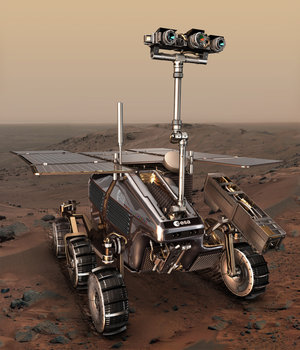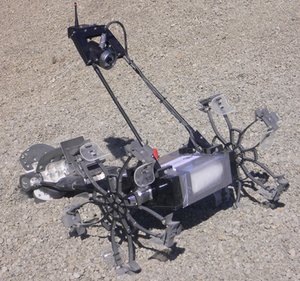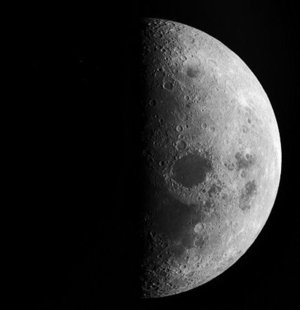Lunar Robotics FAQ's
Here are answers to some of Lunar Robotics' most frequently asked questions.
Q: We are an ESA Member State university. As a prime contractor, can we participate in the Lunar Robotic Challenge with a non Member State University?
A: Should non Member State universities participate in the Lunar Robotic Challenge, they can only do so on a zero cost basis.
Q: Soil properties and rock distribution may vary a lot along lunar surface. It is not stated which kind of environment can be expected on the sampling site, except the image of 'typical' crater.
Do we need to prepare for the worst-case, or does the mission have a possibility to select a more favourable landing site?
A: In a Lunar mission aimed at the exploration of polar craters, many factors will influence the choice of the landing site. The predominant factors are related to safety of landing (reasonably flat terrain must be chosen) and sun illumination (a spot well lit by the sun is needed). It is not possible to assume that while accommodating these two factors, an "easy" access to a crater will be within the reach of a rover. Therefore it is requested that the rover is engineered for a reasonable worst-case.
Q: Can you define soil properties the robotic means needs to cope with? Grain size, density, cohesion, thickness of loose soil layer; on the rim, slope and at the bottom of the crater separately.
A: The ITT purposely did not contain quantitative information on soil properties. The reasons for this are:
- The design of locomotion of the robotic means is dominated by the challenge of descending/ascending unconsolidated slopes (up o 40 degrees), covered by granular loose soil. These slopes exhibit fluid-like flows of soil, resulting in slides whenever the soil is loaded. In this situation rigorous trafficability approach to the design of locomotion would be largely insignificant.
- Search for an exact analogy of lunar soil in a crater environment on Earth would have made impossible finding a venue for the LRC. The chosen venue for the LRC exhibits unconsolidated slopes of 40 degrees or less covered by granular very-loose soil
For educational purposes, a good reference on lunar soil is: V. Gromov and W.D.Carrier, "Physical and mechanical properties of lunar soil" in Engineering, construction, and operations in space - III: Space '92; Proceedings of the 3rd International Conference, Denver, CO, May 31-June 4, 1992. Vol. 1 (A93-41976 17-12), p. 518-527
Q: Can you define rock distribution? - Size variation of rocks and abundance of each size. - On the rim, slope and at the bottom of crater separately
A: The ITT purposely did not contain quantitative information on distribution of boulders (rock outcrops have not been characterised inside/in vicinity of craters). A picture of a real crater was considered more meaningful for the purpose of the challenge. The reasons for this are:
- i) in rover design boulder distribution is used to determine Mean Free Path and rover characteristics such as steering radius and ground clearance. All these engineering characteristics are capital for rovers moving on nominal conditions. However their importance in the case of descent/ascent in/from a crater is minor with respect to other factors.
- ii) the selected Lunar Robotics Challenge venue although offering a boulder distribution similar in appearance to a Lunar crater does not match established models of Lunar boulder distribution.
For educational purposes, good references on distribution of boulders are: [a] Cameron, W. S. & Coyle, G. J. "An Analysis of the Distribution of Boulders in the Vicinity of Small Lunar Craters" on Moon Journal, Volume 3, Issue 2, pp.159-188, and [b] G. D. Bart, H. J. Melosh, "Low Velocity Ejection Of Boulders From Small Lunar Craters: Ground Truth For Asteroid Surfaces" in Lunar and Planetary Science Conference XXXV, March 15-19 2004.
Q: The ITT documents state that the working time is less than 8 months. Can you confirm that the challenge date is in October 2008, only 5 months from now?
A: We confirm that the challenge date is in October 2008
Q: The documents indicate the ESA desires to see new innovative concepts to compete with 'traditional' wheeled ones. Would a wheel-based concept proposal be considered less interesting than concepts based on different technologies?
A: There is no preclusion to the use of any concept, provided that it has a realistic chance of working.
Q: There is contradicting information about number of proposal copies; 13 copies and 4 copies have been requested. How many copies of proposal are requested?
A: The offer shall be submitted in 13 paper copies and 13 CD-ROMs.
Q: The Lunar Rover Challenge states that 'major industrial development' is not allowed. How is this 'major development' defined?
A: General goals of the Lunar Rover Challenge are to involve university students and to benefit from their creativity. Industrial participation shall therefore be limited to consultancy and support to manufacturing, assembling and test. Industry shall not provide the main concept nor be driving design, manufacturing, assembly and testing of the robotic means. Industry participation shall be without compensation.
Q:Would it be allowed to use existing robotic platforms, for example from previous ESA-projects, with some applicable modifications?
A: There is no preclusion for any team to the use of prior art, provided that the team has the right to use it. In the case of ESA projects though, in order to maintain a fair competition, ESA will not furnish any team with any outcome of previous ESA projects.









